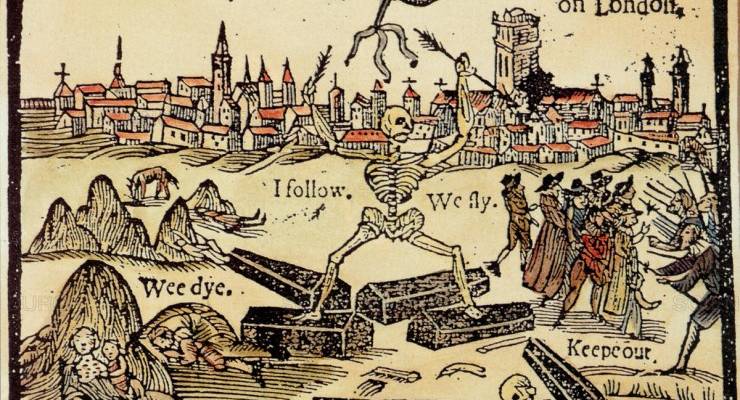
During the long months of lockdown, millions of ambitious writers have been bashing out the great pandemic novel/screenplay. Most will be terrible. But perhaps a handful might come close to capturing the surreal disquiet of the past months.
While 2020 is a year none of us will be eager to relive any time soon, it’s only a matter of time before the first wave of corona-lit is upon us. The maddening, loneliness of lockdown, the helplessness of watching death close in, the banality of a million zoom calls are, whether we like it or not, all fertile artistic and literary terrain.
And for centuries, literature has had a morbid fascination with plagues — from Boccacio’s The Decameron to Mantel’s Wolf Hall, by way of Poe and Shelley and Camus.
Seeping into the aesthetic
Six months which have so radically reshaped our world should shape our cultural output for years to come. Or perhaps not. Perhaps COVID-19 will go the way of the last great pandemic, which quietly slipped of our historical and cultural memory, overlooked in favour of stories of war, conquest and valour.
The marginalisation of the Spanish Flu is perhaps best reflected in a literary and artistic impact that, on the surface, feels rather muted for a disease that killed millions. At first glance, modernism, the great awakening that burst out of the wreckage of WWI, had little to say about the pandemic.
In December last year, rather providentially, American scholar Elizabeth Outka’s book Viral Modernism: The Influenza Pandemic and Modernist Literature was released, providing a long overdue assessment of the Spanish Flu’s true cultural impact.
Outka argues that art didn’t forget the Spanish Flu. Indeed, many of the moment’s key literary and artistic figures had suffered and lost. Instead, illness seeped into the aesthetic of modernism — in the the haunted, sickly tableaux of T. S. Eliot’s The Waste Land, the apocalyptic disquiet of W. B. Yeats’ The Second Coming, the nightmarish horrors of Lovecraft.
A sinister menace
Maybe that’s how COVID-19 will be immortalised — a sinister menace humming away in the background. In a sense, it sometimes feels like COVID-19 is going that way for many of us. After the shock and awe of the first wave, the virus became a kind of unpleasant background noise the world got used to, perhaps at our peril.
We’re already starting to move on and get distracted by other things. They’re having pool parties in Wuhan. Europe seems hell-bent on proceeding with its hedonistic summer as cases rise. In the United States, where the virus continues to kill and maim, it’s quickly become a footnote to so many other American ailments — systemic racism, police brutality, the shitshow in the White House, an election nobody can look away from.
But the pandemic will probably have a deep impact on the art that comes, just not in the way we expect. Because the virus’ greatest parting shot is a sense of economic devastation that will linger for years to come. The cold logic of capitalism will drive so many away from the kind of risk-taking which will breed the great pandemic stories.
Australia is a perfect example — we’re already watching our arts and cultural sectors wither and die, squeezed by the invisible hand and an indifferent government. Just yesterday, Monash closed its centre for theatre and performance, as higher education jobs around the country vanish.
And so, 2020 could make just a small ripple in our cultural memory. Its impact will be quiet. And the stories which we hear will be painfully middle class.








There persists the 19th century assumption, in regard to civilisations, that events and circumstances improve and we have, inter alia, Terry Eagleton and Steven Pinker to remind us. On the one hand (it is a simple exercise) the flu of 1919 had disappeared from public discussion by 1923 and one might conjecture a decade for the Black Death. The cholera epidemics of the 19th century, just for London, disappeared from the public mind within the year of a survey of The Times can be relied upon.
The Covid-19 incident is, by comparison, a non event. Only a fraction of the population become infected and about 96% recover completely; about 2% die; depending upon the region but the percentage is not high (for lethal viruses as a whole).
Yet, it actually isn’t clear that civilisations continue to improve because there have been obvious and complete declines over the last 3,800 years; not to say annihilations. As to your conclusions take note that in all cases of decline it was the literate (read educated) who were the first to starve. Those who could get along on their knuckles survived.
And when the NoLedge class have snuffed it, the machine of urbanity ceases to function.
The mass of the population have no reason to even inhabit the ruins as they serve no purpose and even the memory can be lost in 3 generations.
My favourites are Mohenjo Daro & Harappa only found in 1930s.
There is, of course, a slight difference between COVID and the plague, which is that the latter was almost invariably fatal, no matter what the age of the sufferer, whereas the former is very rarely so.
Cartoons depicting the plague invariably contain skeletons, graves, etc. A cartoon depicting Melbourne at the moment would show people waiting in line to pick up takeaway coffee.
The main difference being bacturum and a virus. The main similarly being that most survived.